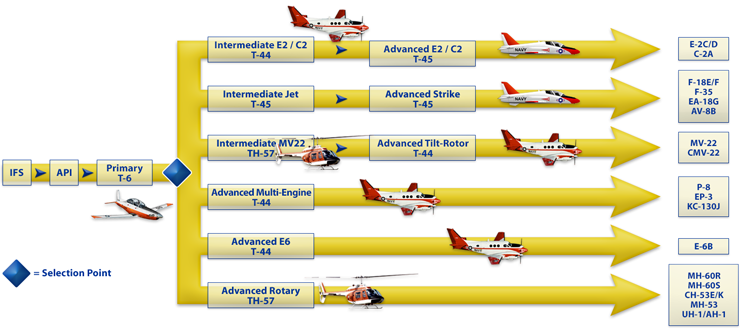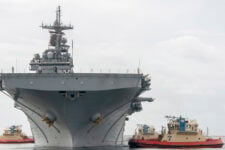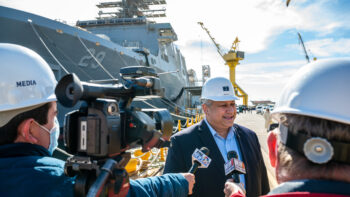
The Navy will replace all 115 of its aged TH-57 Sea Ranger training helicopters with the AW119 helicopter from Leonardo.
WASHINGTON: To better prepare pilots to fly advanced rotorcraft like the Marine Corps’ MV-22 Osprey tiltrotor, the Navy announced this week that it will replace all 115 of its aged TH-57 Sea Ranger undergraduate flight training helicopters with the AW119 single-engine helicopter from Italy’s Leonardo.
Under the $648 million Advanced Helicopter Training Systems (AHTS) program, the Navy awarded Leonardo Helicopters a base-year contract worth $176.5 million for the production of 32 aircraft designated the TH-73A. The Navy plans to buy up to 130 aircraft under a firm-fixed-price contract that include the base year plus three option years out to 2024.
The TH-73 will serve as the basic platform to train all student aviators selected for fleet service in the Navy’s MH-60R/S Seahawk/Knighthawk, UH-1/AH-1 Iroquois/Super Cobra, and CH-53E/K Super Stallion/King, as well as the Coast Guard’s HH-65 Dolphin and MH-68 Stingray. It will also provide rotary wing training for all Navy and Marine Corps aviators training to fly the MV-22.
“The new Leonardo TH-73A helicopters are the cornerstone of AHTS, which is the planned replacement to address the capability and capacity gaps of the current aging TH-57 Sea Ranger helicopter training platform,” Capt. Todd St. Laurent, program manager for Naval Undergraduate Flight Training Systems (PMA-273) at Naval Air Station Patuxent River, said in a statement. The TH-73A will provide a training platform for “the foreseeable future. These new helicopters will ensure the Navy has capacity to train several hundred aviation students per year at Naval Air Station Whiting Field in Milton, Florida.”
The AW119 is a commercial off-the-shelf aircraft, as were the other competitors—Bell Textron and Airbus Helicopters. No performance attributes stood out to elevate one competitor over the other. The Navy will offer its reasoning for its selection at a later date. Maybe the most interesting part of the acquisition is that it went to a non-U.S. company.
“The 119 isn’t the lowest-cost solution; the (Bell) 407 would have been less expensive,” observed Richard Aboulafia, vice president of analysis at the Teal Group. “None of the three competitors are used extensively as trainers. So, I’m not sure what the deciding factor was.
“But as with the UH-72, it clearly shows that the U.S. military is the most neutral contractor in the world when it comes to keeping competitions open for international companies,” he observed, noting the Airbus-built UH-72 Lakota helicopter that won the Army’s Light Utility Helicopter program in 2006.
Replacing the TH-57
PMA-273 acquires, develops and maintains all undergraduate Navy training aircraft for the Chief of Naval Aviation Training at Naval Air Station Corpus Christi. 
This graphic shows the training pipeline for the TH-57, soon to be replaced by the TH-73, and other PMA-273 training aircraft.
The Sea Rangers suffer from an aged airframe—not in dog years or people years but in metal fatigue years. The design dates back to the early 1960s, and the 115 units flying for the Navy were procured in the 1980s. They are increasingly difficult to maintain due to obsolescence and material failure.
Second, they lack advanced cockpit avionics like integrated flight management systems or enhanced night vision. That means they aren’t providing pilot trainees with all the skills they need to fly modern Navy, Marine Corps, and Coast Guard helicopters and tiltrotors. Also, the cost and time to upgrade the Sea Rangers would be prohibitive.
Third, the Sea Ranger’s Allison (Rolls-Royce) 250-C20BJ turbofan engine is an older version with only 420shp. In contrast, Leonardo’s AW119 engine is a 1,000shp Pratt & Whitney Canada PT6B turbofan, which also powers the Navy T-6B primary trainer.
Lower-power engines are prone to over torquing on some maneuvers, especially when inexperienced students are on the throttle. That leads to higher maintenance costs and increased time in the maintenance hangar. As a result, heavy depot maintenance for the airframe and engine that once cost the Navy several hundred thousand dollars for each helicopter in five-year intervals now costs upwards of $1 million per helicopter.
Those realities make it difficult for the 115 TH-57’s in the trainer fleet to meet future pilot training needs as they have no room to grow. The Navy forecasts an annual requirement for more than 600 rotary wing and tiltrotor pilots—a quantity expected to increase through at least 2040. Helicopter and tiltrotor pilots already make up more than 50 percent of all naval aviators.
The Competition
The TH-73 contract was a competition among Leonardo Helicopters, Bell Textron, and Airbus Helicopters (formerly known as Eurocopter). The Navy press release announcing the award, however, noted that five companies submitted proposals for the AHTS program. The names of the other two competitors have not been revealed by the Navy or by the competitors.
“The Naval Air Systems Command does not intend on disclosing the names of all offerors or their proposed solutions,” a Navy spokesperson told Breaking D. “The government received five timely proposals by the April 2, 2019 proposal due date in support of the TH-73A competition.”
The three named competitors all offered existing commercial aircraft with current FAA Airworthiness Type Certificates and applicable Supplemental Type Certificates, as the Navy requested. The AHTS program is a non-developmental acquisition that precluded cutting-edge technologies like dual-coaxial rotors for speed and maneuverability.
A key benefit and cost savings from this type of acquisition relates to aircraft maintenance since the government can largely rely on the existing commercial supplychain and existing facilities.
Leonardo’s AW119 operates in 40 countries and includes customers such as the Portuguese Air Force, the South Korean National Police, and the New York City Department of Environmental Protection Police. Israel’s Air Force announced the selection of the AW119 as its trainer helicopter one year ago.
“The TH-73A will reduce the time to train over the legacy helicopters in that all training flights will take place in a single configuration of the helicopter,” said Andrew Gappy, director of Navy, Marine Corps, and Federal Programs for Leonardo Helicopters. “Unlike the TH-57 B/C which requires two different models and multiple configurations to accomplish its syllabus. “Additionally the TH-73A provides a modern platform for flight instruction and strong foundation for transitioning student pilots to combat helicopters. It was the first Instrument Flight Rules single engine helicopter certified by the FAA in decades, allowing pilots to operate the aircraft safely in low visibility and challenging weather conditions thanks to advanced avionics by Genesys Aerosystems and redundant electrical and hydraulic systems.”
The helicopter will be built and supported at Leonardo’s existing FAA Part 21 production facility in Philadelphia (the former AgustaWestland plant) that produces all AW119 variants worldwide.
While competing for the TH-73 contract, Leonardo had said it would construct an approximately 100,000-square foot support facility adjacent to Naval Air Station Whiting Field, where all helicopter pilots are trained. Developed in partnership with the Santa Rosa County Economic Development Office and Space Florida, the facility will be a Part 145 Repair Station providing 24/7 service including spare parts, warranty processing and renewal, technical and product engineering, and component and airframe repair.
Gappy said that roughly 700 existing full-time positions in Philadelphia will be sustained by the Navy contract with an additional 40-50 new jobs in northwest Florida at the repair center.
Some thought Bell had the inside track for the competition because its entry, the 407GXi, shares its lineage with the TH-57 Sea Ranger, which is itself based on the Bell Jet Ranger 206. The single-engine 407GXi has comparable powertrain, airframe, and support equipment to the TH-57.
Airbus went in the opposite direction with its offering, the H135, which has little in common with the TH-57. It’s got a twin-engine configuration and uses a composite airframe instead of metal. It argued that the complexity and cost of maintaining dual engines would be offset by the ability to due away with autorations (except in a simulator) and minimize the stress they put on the airframe and powerplant.
A Navy spokesperson, however, said the the service didn’t have a preference for either a single-or dual-engine configuration.
“The TH-73A competition was engine quantity agnostic and did not indicate a preference toward a single-engine or twin-engine solution. As a result, it is not more or less important to have a single-engine vs. a twin-engine aircraft.”
The Navy plans to sunset the TH-57s between 2022 and 2024.
HASC adds Virginia-class sub, cuts F-35s in $849.8 billion draft defense policy bill
The bill sticks to budget caps laid out by the Fiscal Responsibility Act.


























